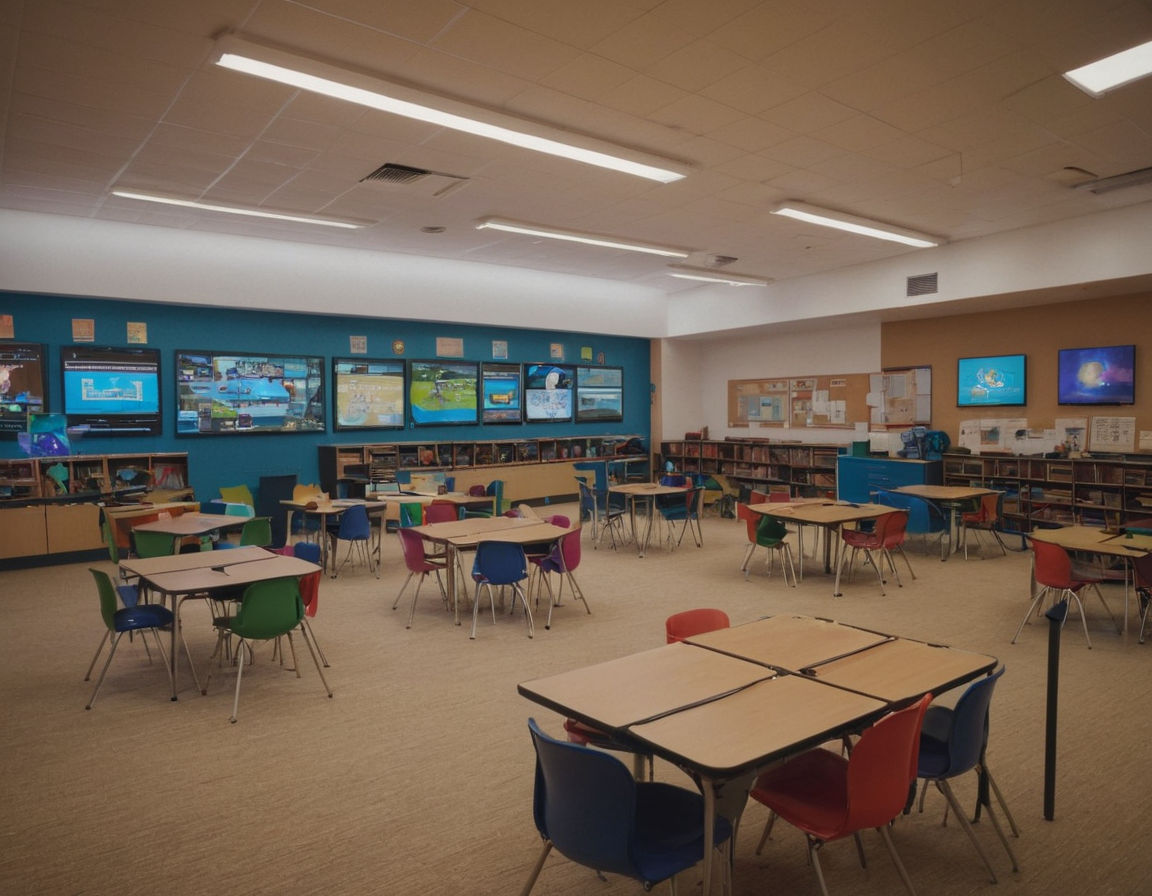Introduction
Educational Video Games offer a unique approach to learning by leveraging the engaging and interactive nature of video games to enhance educational outcomes. These games are specifically designed to educate users on various subjects while offering an enjoyable and immersive experience. Integrating elements of play with educational content, these games aim to make learning more engaging, exciting, and effective for students.
The Significance of Using Video Games in Education lies in their ability to cater to diverse learning styles and preferences. By incorporating gamification elements, educational video games can increase student motivation, stimulate critical thinking, and improve retention of information. Furthermore, these games provide a safe environment for students to make mistakes, learn from trial and error, and develop problem-solving skills.
In a Brief Overview of the Topic, the use of video games in educational settings has gained popularity in recent years due to advancements in educational technology and the growing recognition of the benefits of game-based learning. As educators seek innovative ways to engage students and improve educational outcomes, the integration of educational video games into curricula has shown promising results.
The Role of Gamification in Education
Understanding Gamification in an Educational Context
Gamification involves the integration of game design elements and mechanics into non-game contexts, such as education, to motivate participation, engagement, and learning. In an educational setting, gamification can incentivize students to actively participate in lessons, complete assignments, and strive for mastery of the subject matter.
Benefits of Gamification in Learning
Increases student motivation and engagement.
Enhances collaboration and social interaction among students.
Provides immediate feedback to encourage continuous learning and improvement.
Fosters a sense of achievement and accomplishment, boosting student morale and self-esteem.
Examples of Successful Gamified Educational Platforms
Kahoot!: A popular platform that allows educators to create interactive quizzes and games for students, promoting active learning and knowledge retention.
Classcraft: Utilizes game mechanics to create a collaborative and engaging classroom environment where students work together to achieve common goals and develop essential skills.
Learning Principles in Video Game Design
Educational video games leverage a variety of Learning Principles to create effective learning experiences for students.
Incorporating Learning Principles in Educational Video Games
Active Learning: Encourages students to engage with the content actively through problem-solving, exploration, and decision-making.
Feedback Loops: Provide immediate feedback to guide students towards correct answers or better strategies.
Scaffolding: Gradually increases the complexity of tasks to match students' learning levels and ensure a challenging yet achievable learning experience.
The Impact of Learning Principles on Student Engagement
By aligning educational video games with learning principles, educators can increase student Engagement in the learning process. These principles help create a supportive and interactive learning environment where students are motivated to explore, experiment, and learn at their own pace.
Examples of Learning Principles Implemented in Popular Video Games
Minecraft: Encourages creativity, problem-solving, and collaboration among players while allowing freedom to explore and build within the game world.
Portal: Challenges players with puzzles that require critical thinking, spatial reasoning, and the application of physics principles to progress in the game.
Case Studies: Successful Educational Video Games

Video games have moved beyond traditional entertainment to become valuable tools in educational settings. Specific educational video games are designed with learning objectives in mind, offering engaging experiences that foster skills development and knowledge acquisition. By integrating gamification principles, these games aim to enhance learning outcomes while promoting student engagement.
Overview of Specific Video Games Used for Educational Purposes
"Minecraft Education Edition"
This popular sandbox game allows students to explore, create, and collaborate in a virtual world.
Teachers can leverage its versatile platform to teach subjects like history, science, and even coding.
"Kahoot!"
Known for its interactive quizzes and surveys, Kahoot! encourages student participation and knowledge retention through game-based learning.
It promotes engagement through friendly competition and real-time feedback.
Analyzing the Effectiveness of Video Games on Educational Outcomes
Research has shown that educational video games can positively impact learning outcomes by:
Enhancing problem-solving skills.
Improving critical thinking abilities.
Boosting motivation and student engagement.
Providing a context for practical application of knowledge.
Student Experience and Feedback on Learning Through Games
Students often report increased motivation and enjoyment when learning through games. The interactive and immersive nature of educational video games can make learning more appealing and effective. Feedback mechanisms within games allow for immediate assessment, enabling students to track their progress and receive instant reinforcement.
Strategies for Integrating Educational Video Games into Curriculum
Incorporating educational video games into the curriculum requires thoughtful planning and strategic implementation to maximize their benefits without overshadowing traditional teaching methods.
Practical Tips for Teachers to Incorporate Games in Teaching
Align game objectives with curriculum standards.
Provide clear instructions and objectives to students.
Offer opportunities for collaboration and discussion during gameplay.
Monitor student progress and provide feedback accordingly.
Curriculum Integration of Video Games
Integrating video games into the curriculum involves:
Identifying learning objectives that can be met through gaming.
Mapping game activities to specific topics or skills.
Establishing clear guidelines for game usage and evaluation.
Connecting game-based learning to real-world applications.
Balancing Video Games with Traditional Teaching Methods
While educational video games offer unique benefits, it's crucial to strike a balance with traditional teaching methods to ensure a comprehensive learning experience. Teachers can use games as supplementary tools to reinforce concepts, promote engagement, and cater to diverse learning styles.
Interactive Education Through Video Games
Interactive education through video games leverages the immersive and customizable nature of gaming to create engaging learning experiences that resonate with students.
Interactivity as a Tool for Enhanced Learning

Interactivity in educational video games allows for:
Personalized learning experiences.
Immediate feedback and reinforcement.
Adaptive content tailored to individual progress.
Collaboration and social learning opportunities.
Features of Interactive Education in Video Games
Key features of interactive education in video games include:
Gamified reward systems for achievements.
Decision-making scenarios that impact outcomes.
Simulation of real-world challenges for practical application of knowledge.
Engagement through storytelling and narrative-driven gameplay.
Examples of Interactive Educational Video Games
"Prodigy"
An adaptive math game that adjusts difficulty based on student performance.
Incorporates quests, battles, and character development to make learning fun.
"Zoombinis"
A logic-based game that challenges students to solve puzzles and guide characters to safety.
Promotes critical thinking, deductive reasoning, and problem-solving skills.
By exploring these successful case studies, strategies for curriculum integration, and the role of interactivity in educational video games, educators can harness the power of gamification to create dynamic and engaging learning environments for students.
The Future of Educational Technology
In recent years, the integration of technology in education has significantly evolved, with educational institutions embracing innovative tools to enhance learning experiences. One prominent trend that has gained traction is the use of educational video games. These games, designed specifically for educational purposes, are proving to be valuable assets in engaging students and improving educational outcomes.
Evolution of Educational Technology in the Classroom
The evolution of educational technology has seen a shift from traditional methods of teaching to more interactive and engaging approaches. In the past, technology in the classroom mainly comprised of computers and projectors. However, with advancements in technology, educators now have access to a wide range of tools, including educational video games, virtual reality simulations, and interactive learning platforms.
Educational video games have become particularly popular due to their ability to make learning fun and engaging. By incorporating elements of gamification, such as rewards, competition, and problem-solving challenges, these games can effectively motivate students to actively participate in the learning process.
Emerging Trends in Game-Based Learning and Educational Technology
The use of game-based learning in educational settings is a growing trend that is reshaping traditional teaching methods. This approach leverages the immersive and interactive nature of video games to create dynamic learning experiences that cater to different learning styles. Students can benefit from personalized learning paths, instant feedback, and the ability to learn at their own pace.
Moreover, educational technology is placing a strong emphasis on adaptive learning, where the content and difficulty level adjust based on the student's progress and performance. This personalized approach not only enhances engagement but also improves retention and knowledge acquisition.
Future Prospects and Innovations in Educational Video Games
Looking ahead, the future of educational technology holds promising prospects for the continued integration of video games in learning environments. Developers are focusing on creating more sophisticated educational games that align with curriculum standards and learning objectives. These games aim to supplement traditional teaching methods by offering interactive activities that reinforce key concepts and skills.
Innovations such as augmented reality and artificial intelligence are also shaping the landscape of educational video games. By incorporating these technologies, developers can create immersive experiences that blur the lines between the virtual and physical world, providing students with hands-on learning opportunities that were previously unimaginable.
As educational institutions continue to recognize the value of educational video games in enhancing student engagement and learning outcomes, we can expect to see further advancements in this field, ultimately reshaping the future of education.




